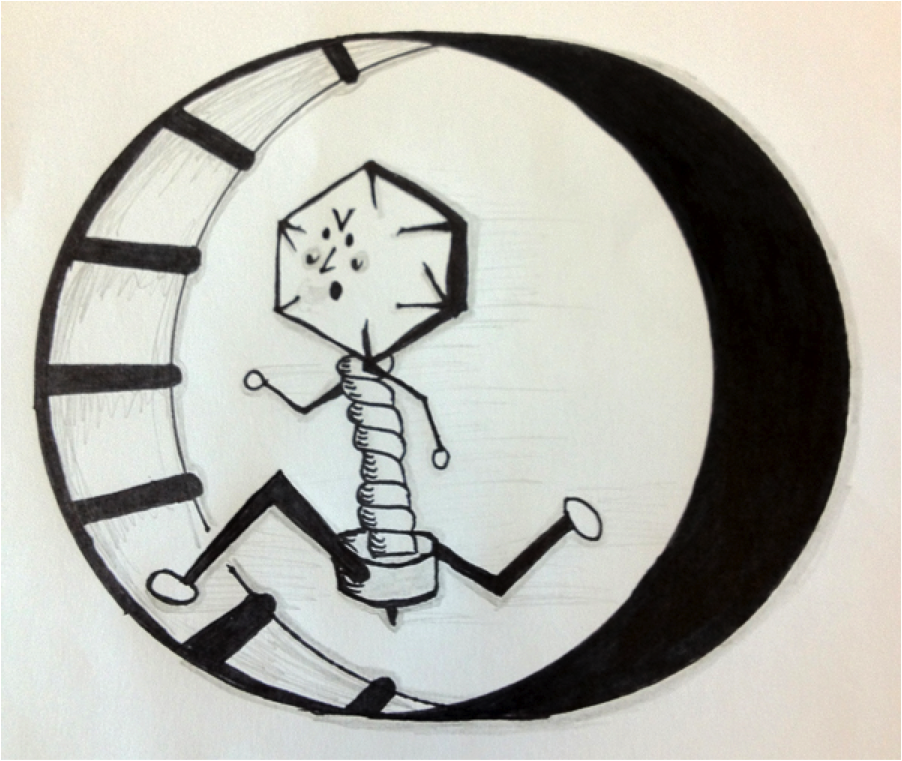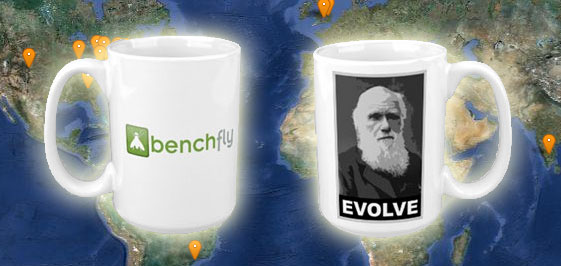This is Not an Article About Running Viruses…
by
…but when I saw the headline “scientists generate electricity from viruses” this is where my mind went:
Just hook that little guy up to a generator, and boom! Electricity!
Sadly that’s not really how these scientists are making electricity from viruses. I mean, if I really think about it, there are several flaws to my idea: 1. How do you build a teeny tiny wheel? 2. How many teeny tiny wheels would you have to build to generate a sizeable amount of electricity? 3. How do you train the viruses to run on said teeny tiny wheels?
The way the authors of this Nature Nanotechnology paper did use their viruses, however, is pretty ingenious.
Their experiments were based on a phenomenon known as piezoelectric energy. This is the conversion of small amounts of mechanical energy, such as vibrations or strain, into electricity. For example, piezoelectric devices can harvest the vibrational energy produced by human footsteps if they are placed under a sidewalk. The amount of piezoelectricity generated is small, but there is potential for using it in small devices such as wristwatches and other hand-held devices. Harvesting this kind of energy relies on the specific physical and chemical properties of certain materials, and the major roadblocks to the widespread use of piezoelectric energy are the toxic chemicals needed to make these materials.
Enter biopiezoelectricity. There are several naturally occurring biomolecules that are known to possess piezoelectric energy generation potential. These include bone, collagen, and peptide nanotubes, all of which are inherently tricky to use. One of the key properties of a piezoelectric material is it needs to be organized into a regular, repeating, crystalline structure. Scientists have therefore been on the lookout for biological entities that naturally aggregate in this way. It is also important to be able to generate these molecules in large quantities; something that has also been an issue with previously characterized biopiezoelectric generators.
Lee and colleagues managed to overcome both of these problems by using a virus. The M13 bacteriophage (a virus that infects E. coli bacteria) is an 880nm-long rod-shaped particle that is made up of repeating protein building blocks called major coat proteins. These coat proteins self assemble, and the resulting rod has both rotational and screw symmetry, features that predispose a molecule to forming regular crystal sturctures. So what Byung Yang Lee and his pals at UC Berkeley did was to grow a large culture of E. coli in a liquid medium, infected the cells with M13, and let biology generate their starting materials for them. Then, they isolated the virus from the bacterial cells, and set about generating a structured crystal. But guess what? The viruses did that on their own too!
The researchers then set about testing this potentially piezoelectric material. They found that, with some genetic tweaking of the precise composition of the major coat protein, and by stacking the virus crystals into 7-layer deep arrays, they could generate up to 6 nano-Amps of current and 400 milli-volts of potential. Using this generator, they could power a small liquid crystal display, similar to those found in digital watches.
So, while this paper doesn’t describe the athletic properties of bacteriophage, it does provide a solution to the problems that have plagued the piezoelectricity field for some time. These self-assembling biomolecules could have direct real world applications in the not-too-distant future.
Piezoelectricity: Coming to an iPod near you soon!
.
Katie Pratt is a graduate student in Molecular Biology at Brown University. She has a passion for science communication, and in an attempt to bring hardcore biology and medicine to everyone, she blogs jargon-free at www.katiephd.com. Follow her escapades in the lab and online on Twitter.
.
Be the first one to mind the gap by filling in the bacteria name as a comment and get your name in the blog along with a sweet new BenchFly mug!
UPDATE – Congratulations to Michele Banks, winner of this week’s Mind the Gap!
About the winner: Michele Banks is a painter based in Washington, DC. Most of Banks’ artwork is inspired by science, particularly biology. Her work has been featured in The Scientist Online and Scientific American and has been exhibited at the National Institutes of Health. Check out her paintings and collages and follow her on Twitter.
About the prize: In addition to fame and glory beyond their wildest dreams, winners receive our new hot-off-the-presses large (15 oz) BenchFly mug to help quench their unending thirst for scientific knowledge… or coffee. Check out where the mug has traveled – will you be the first in your state or country to win one?
Miss a previous edition of Mind the Gap? Shame on you! Don’t worry – we’ve got you covered:
How is a Dormouse Like a Career Scientist?
With Great Power Comes Great Violin Strings
All the Better to See Sperm Whales With, My Dear
Saw VII: The Revenge of the Sawfish
Caution: Objects May Appear Larger Than They Really Are
Facebook Updates: The Good, The Bad, and The Vague
Scared of Dropping the Soap? Worry No More.
A Social Network for Food: Why Won’t Vanilla Friend Garlic?
I’d Rather Die Fat and Young than Old and Skinny
Look Into My Wide, Vacant, Eyes
Sweet Relief: How Sugar May Help Reverse Climate Change




@artologica
wrote on May 16, 2012 at 2:06 pm
E. Coli
alan@benchfly
wrote on May 16, 2012 at 2:10 pm
BINGO! We've got a winner!
Kristen
wrote on May 16, 2012 at 2:13 pm
E. coli!